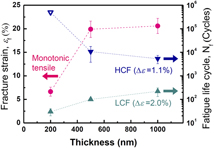Crossref Citations
This article has been cited by the following publications. This list is generated based on data provided by
Crossref.
Hong, Kihyon
Ham, Juyoung
Kim, Byoung-Joon
Park, Jae Yong
Lim, Dong Chan
Lee, Joo Yul
and
Lee, Jong-Lam
2015.
Continuous 1D-Metallic Microfibers Web for Flexible Organic Solar Cells.
ACS Applied Materials & Interfaces,
Vol. 7,
Issue. 49,
p.
27397.
Wan, H.Y.
Luo, X.M.
Li, X.
Liu, W.
and
Zhang, G.P.
2016.
Nanotwin-enhanced fatigue resistance of ultrathin Ag films for flexible electronics applications.
Materials Science and Engineering: A,
Vol. 676,
Issue. ,
p.
421.
Kim, Byoung-Joon
Shin, Hae-A-Seul
Lee, Ji-Hoon
and
Joo, Young-Chang
2016.
Effect of cyclic outer and inner bending on the fatigue behavior of a multi-layer metal film on a polymer substrate.
Japanese Journal of Applied Physics,
Vol. 55,
Issue. 6S3,
p.
06JF01.
Luo, X.M.
and
Zhang, G.P.
2017.
Grain boundary instability dependent fatigue damage behavior in nanoscale gold films on flexible substrates.
Materials Science and Engineering: A,
Vol. 702,
Issue. ,
p.
81.
Glushko, Oleksandr
Klug, Andreas
List-Kratochvil, Emil J.W.
and
Cordill, Megan J.
2017.
Monotonic and cyclic mechanical reliability of metallization lines on polymer substrates.
Journal of Materials Research,
Vol. 32,
Issue. 9,
p.
1760.
Lee, Hye Jin
Jung, Dae-Han
Kil, Tae-Hyeon
Kim, Sang Hyeon
Lee, Ki-Suk
Baek, Seung-Hyub
Choi, Won Jun
and
Baik, Jeong Min
2017.
Mechanically Robust, Stretchable Solar Absorbers with Submicron-Thick Multilayer Sheets for Wearable and Energy Applications.
ACS Applied Materials & Interfaces,
Vol. 9,
Issue. 21,
p.
18061.
Cordill, M.J.
Glushko, O.
Kleinbichler, A.
Putz, B.
Többens, D.M.
and
Kirchlechner, C.
2017.
Microstructural influence on the cyclic electro-mechanical behaviour of ductile films on polymer substrates.
Thin Solid Films,
Vol. 644,
Issue. ,
p.
166.
Luo, Xue-Mei
and
Zhang, Guang-Ping
2017.
Deformation-mechanism dependent stretchability of nanocrystalline gold films on flexible substrates.
Journal of Materials Research,
Vol. 32,
Issue. 18,
p.
3516.
Zheng, Si-Xue
Luo, Xue-Mei
Wang, Dong
and
Zhang, Guang-Ping
2018.
A novel evaluation strategy for fatigue reliability of flexible nanoscale films.
Materials Research Express,
Vol. 5,
Issue. 3,
p.
035012.
Kim, Cheol
and
Kim, Chung
2018.
Universal Testing Apparatus Implementing Various Repetitive Mechanical Deformations to Evaluate the Reliability of Flexible Electronic Devices.
Micromachines,
Vol. 9,
Issue. 10,
p.
492.
Yi, Seol-Min
Choi, In-Suk
Kim, Byoung-Joon
and
Joo, Young-Chang
2018.
Reliability Issues and Solutions in Flexible Electronics Under Mechanical Fatigue.
Electronic Materials Letters,
Vol. 14,
Issue. 4,
p.
387.
Muralidharan, Roshan
Raj, Arun
Sivasubramony, Rajesh Sharma
Yadav, Manu
Alhendi, Mohammed
Nilsson, Matthew
Greene, Christopher
Poliks, Mark D.
and
Borgesen, Peter
2019.
Effect of substrate properties on isothermal fatigue of aerosol jet printed nano-Ag traces on flex.
Journal of Materials Research,
Vol. 34,
Issue. 16,
p.
2903.
Shinde, Mahesh A.
Lee, Dong-Jun
Kim, Byoung-Joon
and
Kim, Haekyoung
2019.
Highly conductive and smooth surfaced flexible transparent conductive electrode based on silver nanowires.
Thin Solid Films,
Vol. 685,
Issue. ,
p.
366.
Luo, XueMei
Zhang, Bin
and
Zhang, GuangPing
2019.
Fatigue of metals at nanoscale: Metal thin films and conductive interconnects for flexible device application.
Nano Materials Science,
Vol. 1,
Issue. 3,
p.
198.
Kim, Tae-Wook
Lee, Jong-Sung
Kim, Young-Cheon
Joo, Young-Chang
and
Kim, Byoung-Joon
2019.
Bending Strain and Bending Fatigue Lifetime of Flexible Metal Electrodes on Polymer Substrates.
Materials,
Vol. 12,
Issue. 15,
p.
2490.
Wang, Fang
Luo, Xue-Mei
Wang, Dong
Schaaf, Peter
and
Zhang, Guang-Ping
2019.
Fatigue behavior of nanoscale Mo/W multilayers on flexible substrates.
MRS Advances,
Vol. 4,
Issue. 43,
p.
2309.
Park, Minkyu
Kim, Wonsik
Hwang, Byungil
and
Han, Seung Min
2019.
Effect of varying the density of Ag nanowire networks on their reliability during bending fatigue.
Scripta Materialia,
Vol. 161,
Issue. ,
p.
70.
Lee, Dong-Jun
Lee, Jong-Sung
Kim, Tae-Wook
Lee, So-Yeon
Park, Young-Bae
Joo, Young-Chang
and
Kim, Byoung-Joon
2019.
Effect of the Thermal Annealing on the Stretchability and Fatigue Failure of the Copper Film on the Polymer Substrate.
Journal of Electronic Materials,
Vol. 48,
Issue. 7,
p.
4582.
Chen, Hong-Lei
Luo, Xue-Mei
Wang, Dong
Ziegler, Mario
Huebner, Uwe
Zhang, Bin
and
Zhang, Guang-Ping
2019.
Length-scale dominated thermal fatigue behavior in nanocrystalline Au interconnect lines.
Materialia,
Vol. 7,
Issue. ,
p.
100337.
Bag, Atanu
Park, Ki-Seong
and
Choi, Shi-Hoon
2019.
Effect of the Deformation State on the Mechanical Degradation of Cu Metal Films on Flexible PI Substrates During Cyclic Sliding Testing.
Metals and Materials International,
Vol. 25,
Issue. 1,
p.
45.





